List of Egyptian mummies (royalty)
The following is a list of mummies that include Egyptian pharaohs and their named mummified family members.[lower-alpha 1] Some of these mummies have been found to be remarkably intact, while others have been damaged from tomb robbers and environmental conditions. It was not until Pharaoh Den of the first dynasty that things such as a staircase and architectural elements were added which provided better protection from the elements.[1]
Identified
| Image | Name | Alias | Year of death | Dynasty | Sex | Year discovered | Description |
|---|---|---|---|---|---|---|---|
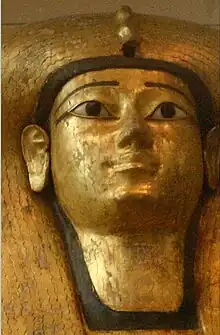 |
Ahhotep II | — | Unknown | 17th | Female | 1858 | The mummy of Ahhotep II was destroyed in 1859.[2] |
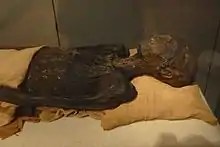 |
Ahmose (princess) | — | Unknown | 17th | Female | 1903-1905 | Princess Ahmose was buried in tomb QV47 in the Valley of the Queens.[3] Her mummy was discovered by Ernesto Schiaparelli during his excavations from 1903-1905.[4] |
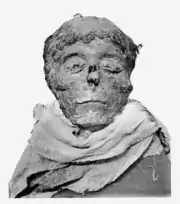 |
Ahmose I | Amasis | 1525 BC | 18th | Male | 1881 | Ahmose I's mummy was discovered in 1881 within the Deir el-Bahri Cache. His name was later found written in hieroglyphs when the mummy was unwrapped. The body bore signs of having been plundered by ancient grave-robbers, his head having been broken off from his body and his nose smashed.[5] |
 |
Ahmose-Henutemipet | — | Unknown | 17th/18th | Female | 1881 | Ahmose-Henutemipet was found in 1881 entombed in DB320. Her remains were found badly damaged, likely by tomb robbers. |
 |
Ahmose-Henuttamehu | — | Unknown | 17th/18th | Female | 1881 | Ahmose-Henuttamehu was found in 1881 entombed in DB320. Like Ahmose-Henutemipet, she was found to be an old woman when she died as her teeth are worn. |
 |
Ahmose-Meritamon | Meryetamun | Unknown | 17th | Female | Unknown | Ahmose-Meritamon was found entombed in DB320. Like other mummies of the era, she was found to be heavily damaged by tomb robbers. An examination of her mummy shows that she suffered a head wound prior to her death which was the possible result of falling backwards.[6] CT scanning in 2020 estimated her to be in her 50s at death. She had extensively hardened arteries (atherosclerosis) and is suggested to have died of a heart attack. Her unusual pose is likely the position she died in and was mummified in it due to the onset of rigor mortis.[7] |
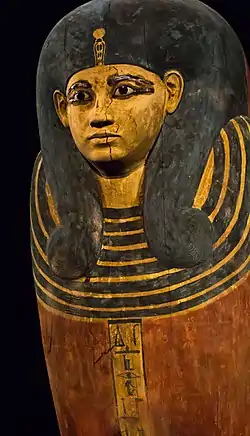 |
Ahmose-Meritamun | Ahmose-Meritamon | Unknown | 18th | Female | 1930 | Her mummy was found carefully rewrapped, which was determined to have occurred during the reign of Pinedjem I. |
 |
Ahmose Inhapy | Ahmose-Inhapi | Unknown | 17th/18th | Female | 1881 | The mummy was found in the outer coffin of Lady Rai, the nurse of Inhapy's niece Queen Ahmose-Nefertari. Her skin was still present, and no evidence of salt was found. The body was sprinkled with aromatic powdered wood and wrapped in resin soaked linen.[8] |
| — | Ahmose-Sitamun | Sitamun | Unknown | 18th | Female | Unknown | Ahmose-Sitamun was found entombed in DB320. At some point she was moved to the Egyptian Museum in Cairo where she remains to this day. |
 |
Ahmose-Sitkamose | Sitkamose | Unknown | 17th/18th | Female | 1881 | Sitkamose's mummy was discovered in 1881 in the Deir el-Bahari cache. Her mummy was unwrapped by Gaston Maspero on June 19, 1886 where it was found to be damaged by tomb robbers. Sitkamose was about thirty years old when she died, Grafton Eliot Smith described her as a strong-built, almost masculine woman.[9] |
| — | Ahmose-Tumerisy | — | Unknown | 17th | Female | Unknown | Ahmose-Tumerisy was an ancient Egyptian princess of the late 17th Dynasty. Since her titles were "King's Daughter" and "King's Sister", it is likely that she was a daughter of pharaoh Seqenenre Tao and a sister of pharaoh Ahmose I. Her name is known from her coffin, which is now in the Hermitage Museum. Her mummy was found in the pit MMA 1019 in Sheikh Abd el-Qurna.[10] |
| — | Amenemhat | Son of Thutmose IV | Unknown | 18th | Male | 1903 | Amenemhat was a prince of the Eighteenth Dynasty of Egypt; the son of Pharaoh Thutmose IV.[11] He is depicted in the Theban tomb TT64, which is the tomb of the royal tutors Heqareshu and his son Heqaerneheh.[12] He died young and was buried in his father's tomb in the Valley of the Kings, KV43, together with his father and a sister called Tentamun.[13] His canopic jars and possible mummy were found there.[14] |
| — | Amenemope | Usermaatre Amenemope | 992 or 984 BC | 21st | Male | 1946 | While the tomb was discovered in 1940, his mummy was not found until the end of World War II. The mummy was found with various jewelry and two funerary masks which are now all displayed at the Cairo Museum. |
| — | Amenemopet | — | Unknown | 18th | Female | 1857 | The mummy of Amenemopet was buried in the Sheikh Abd el-Qurna cache where it was discovered in 1857. |
| Amenhotep I | Amenophis I | 1506 or 1504 BC | 18th | Male | Unknown | His mummy was moved sometime in the 20th or 21st Dynasty for safety, probably more than once. The mummy of Amenhotep I features an exquisite face mask which has caused his body not to be unwrapped by modern Egyptologists. | |
 |
Amenhotep II | Amenophis II | 1401 or 1397 BC | 18th | Male | 1898 | |
 |
Amenhotep III | Amāna-Ḥātpa | 1353 or 1351 BC | 18th | Male | 1898 | [15] |
| — | Ashayet | Ashait | Unknown | 11th | Female | Unknown | |
| — | Djedkare Isesi | Tancheres | Unknown | 5th | Male | 1940s | |
 |
Duathathor-Henuttawy | Henuttawy | Unknown | 20th | Female | Unknown | |
| — | Henhenet | — | Unknown | 11th | Female | Unknown | |
| — | Henuttawy C | Henettawy | Unknown | 21st | Female | 1923-1924 | |
 |
Hornakht | Harnakht | Unknown | 22nd | Male | 1942 | |
| — | Kamose | — | 1550 BC | 17th | Male | 1857 | In 1857, the mummy of Kamose was discovered seemingly deliberately hidden in a pile of debris. Egyptologists Auguste Mariette, and Heinrich Brugsch noted that the mummy was in very poor shape. |
| — | Mayet | Miit | 2010 BC | 11th | Female | 1921 | Mayet's position within the royal family of Mentuhotep II is disputed.[16] It is generally assumed that she was a daughter of the king as she was about five years old when she died. |
 |
Merneptah | Merenptah | 1203 BC | 19th | Male | 1898 | |
| — | Mutnedjmet | Various | 1319 or 1332 BC | 18th | Female | Unknown | |
| — | Nauny | Nany | Unknown | 21st | Female | Unknown | |
| — | Nebetia | — | Unknown | 18th | Female | 1857 | |
| — | Neferefre | Raneferef | Unknown | 5th | Male | Unknown | |
 |
Nesitanebetashru | — | Unknown | 21st | Female | Unknown | |
 |
Pentawer | Pentaweret; Unknown man E | 1155 BC | 20th | Male | Unknown | |
| — | Pyhia | • Pyihia • Petepihu |
Unknown | 18th | Female | 1857 | Pyhia or Pyihia or Petepihu (Ancient Egyptian: p3-ỉḥỉ3) was a princess during the 18th Dynasty, and the daughter of Thutmose IV. Her mummy was reburied in the Sheikh Abd el-Qurna cache along with that of several other princesses: her probable sisters Amenemopet and Tiaa; her niece Nebetia and Princesses Tatau, Henutiunu, Merytptah, Sithori and Wiay. |
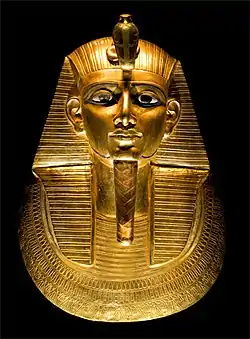 |
Psusennes I | Pasibkhanu | 1001 BC | 21st | Male | 1940 | |
 |
Ramesses I | Ramses | 1290 BC | 19th | Male | 1817 | [17][18] |
 |
Ramesses II | Ramesses the Great | 1213 BC | 19th | Male | 1881 | |
 |
Ramesses III | Usimare Ramesses III | 1155 BC | 20th | Male | 1886 | |
 |
Ramesses IV | Heqamaatre Ramesses IV | 1149 BC | 20th | Male | 1898 | |
 |
Ramesses V | Usermaatre Sekheperenre Ramesses V | 1145 BC | 20th | Male | 1898 | |
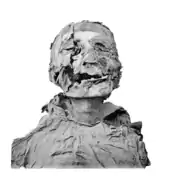 |
Ramesses VI | Ramesses VI Nebmaatre-Meryamun | 1137 BC | 20th | Male | 1898 | |
| — | Ramesses IX | Amon-her-khepshef Khaemwaset | 1111 BC | 20th | Male | 1881 | |
| — | Ranefer | Ranofer | Unknown | 4th | Male | Unknown | |
 |
Seqenenre Tao | • Seqenera Djehuty-aa, • Sekenenra Taa |
Unknown | 17th | Male | 1881 | |
| — | Sesheshet | Sesh | Unknown | 6th | Female | 2009 | |
.jpg.webp) |
Seti I | Sethos I | 1279 BC | 19th | Male | 1881 | [19][20] |
 |
Seti II | Sethos II | 1193 BC | 19th | Male | 1908 | |
 |
Shoshenq II | • Heqakheperre Shoshenq II • Shoshenq IIa |
885 BC | 22nd | Male | 1939 | |
 |
Siptah | Merenptah Siptah | 1191 BC | 19th | Male | 1898 | |
 |
Sitdjehuti | Satdjehuti | Unknown | 17th | Female | 1820 | |
 |
Thutmose II | Various | 1479 BC | 18th | Male | 1881 | [21][22] |
 |
Thutmose III | Various | 1425 BC | 18th | Male | 1881 | |
 |
Thutmose IV | Menkheperure | 1391 or 1388 BC | 18th | Male | 1898 | |
| — | Tiaa (princess) | — | Unknown | 18th | Female | 1857 | |
 |
Tiye | The Older Lady | 1338 BC | 18th | Female | 1898 | Tiye was found to be extensively damaged by past tomb robbers. |
 |
Tutankhamun | King Tut | 1323 BC | 18th | Male | 1922 | See: Tutankhamun's mummy |
 |
Tjuyu | • Thuya, • Thuyu |
1375 BC | 18th | Female | 1905 | |
 |
Webensenu | — | Unknown | 18th | Male | 1898 | Webensenu was an ancient Egyptian prince of the 18th Dynasty. He was a son of Pharaoh Amenhotep II.[23] He is mentioned, along with his brother Nedjem, on a statue of Minmose, overseer of the works in Karnak.[24] He died as a child and was buried in his father's tomb, KV35, where there were found his canopic jars and shabtis. His mummy is still there, and it indicates that he died around the age of ten.[25][26] |
Disputed
The following entries are previously identified mummies that are now in dispute. Over time through the advance in technology, new information comes to light that discredits old findings and beliefs. The mummies that have been lost or destroyed since initial discovery may never be properly identified.
| Image | Alias | Assumed name(s) | Dynasty | Sex | Year discovered | Description |
|---|---|---|---|---|---|---|
 |
— | Ahmose-Nefertari | 18th | Female | 1881 | Ahmose-Nefertari is assumed to have been retrieved from her tomb at the end of the New Kingdom and moved to the royal cache in DB320. Her presumed body, with no identification marks, was discovered in the 19th century and unwrapped in 1885 by Emile Brugsch but this identification has been challenged.[27] When the mummy was found it emitted such a bad odor that it was reburied on museum grounds in Cairo until the offensive smell abated. If this is Ahmose-Nefertari, then she was determined to have died in her 70s. The mummy's hair had been thinning and plaits of false hair had been woven in with its own to cover this up. The body also had been damaged in antiquity and was missing its right hand.[28] Despite the disputed attribution, the mummy was included in the 2021 Pharaohs' Golden Parade. |
 |
— | Ahmose Sapair | 18th | Male | 1881 | In 1881, a mummy of a 5- to 6-year-old boy was found in cache (DB320) and identified as Ahmose-Sipair. This was disputed as Prince Ahmose-Sipair is always portrayed as an adult on the coffin of the scribe and other antiquities, thus the child-mummy cannot be his.[29] |
 |
KV55 mummy | Akhenaten or Smenkhkare | 18th | Male | 1907 | Uncertainty remains over the identity of this mummy as the young age at death is inconsistent with Akhenaten's reign. CT scans done in 2010 strongly suggest that the mummy may be Pharaoh Smenkhkare. |
| — | KV21A | Ankhesenamun | 18th | Female | 1817 | Assumed to be Ankhesenamun, as she is the mother of the two fetuses found in Tutankhamun's tomb. Uncertainty remains if the mummy found in KV55 is accepted to be Akhenaten. She is also known as mummy KV21A, after the tomb that she was discovered in. |
 |
KV60A | Hatshepsut | 18th | Female | 1903 | In 1903, Howard Carter had discovered tomb KV60 in the Valley of the Kings. It contained two female mummies: one identified as Hatshepsut's wet nurse and the other unidentified. The latter of the two (KV60A), was removed from the tomb in 2007 and identified as Hatshepsut by inspecting the mouth. These results have since been disputed from a 2011 study which cited a misplaced molar. |
 |
The Younger Lady | Nebetah, Beketaten or Nefertiti | 18th | Female | 1898 | This mummy was found lying in a side chamber of KV35. The body was extensively damaged by past tomb robbers which caused numerous holes. Early speculation was that the mummy belonged to Queen Nefertiti. DNA testing published in 2010 revealed The Younger Lady is a daughter of Pharaoh Amenhotep III and his chief wife Tiye and the mother of Tutankhamun. This report concluded that the mummy is likely Beketaten, or Nebetah.[30] Despite the DNA results, Egyptologists such as Marc Gabolde and Aidan Dodson support the identification of this body as that of Nefertiti.[31][32] |
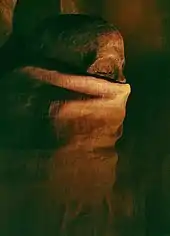 |
— | Merenre Nemtyemsaf I | 6th | Male | 1881 | A mummy was uncovered in 1881 by Émile and Heinrich Karl Brugsch in the black basalt sarcophagus of the burial chamber of the Pyramid of Merenre. The mummy is that of a 1.66 m (5.4 ft)-tall man, already in a poor condition at discovery as ancient tomb robbers had partially torn off its wrappings. The Brugsch brothers further damaged the mummy while transporting it back to Cairo.
Preliminary forensic analyses indicated that it belonged to a young man, with possible traces of his sidelock of youth still visible at the time of discovery. The identity of the mummy remains uncertain as Grafton Elliot Smith, who performed these analyses, observed that the technique employed for the wrapping was typical of the 18th Dynasty rather than the 6th. Re-wrapping of older mummies are known to have occurred so that this observation does not necessarily preclude that the mummy be that of Merenre. The mummy has not been studied since and its identification remains uncertain. |
| The mummy in the boat | Setnakhte | 20th | Male | 1898 | The alleged mummy of Setnakhte has never been identified with certainty, although the so–called "mummy in the boat" found in KV35 was sometimes identified with him, an attribution rejected by Aidan Dodson who rather believes the body belonged to a royal family member of Amenhotep II of the 18th Dynasty. In any case the mummy was destroyed by looters in 1901, thus preventing any analysis on it.[33] | |
 |
Unknown woman B | Tetisheri | 17th/18th | Female | 1881 | No tomb has yet been conclusively identified with Queen Tetisheri, though a mummy that may be hers was included among other members of the royal family that were reburied in the Royal Cache. |
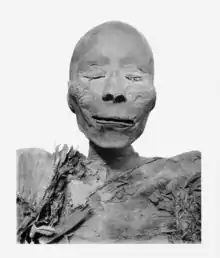 |
— | Thutmose I | 18th | Male | 1881 | Egyptologist Gaston Maspero thought this was the mummy of Thutmose I largely on the strength of familial resemblance to the mummies of Thutmose II and Thutmose III. In 2007 though, Dr. Zahi Hawass announced that the mummy is a thirty-year-old man who had died as a result of an arrow wound to the chest. Due to the young age of the mummy and the cause of death, it was determined that the mummy was probably not of Thutmose I.[34] Despite this, the mummy was included in the 2021 Pharaohs' Golden Parade. |
Notes
- Mummies have been found by archaeologists whom have determined their royal status, but have not been able to provide any real conclusive name. These are usually given informal numbers based on their tomb locations (ex: KV##A (Valley of the Kings) and QV##A (Valley of the Queens). These nameless individuals are not listed here as not enough given information is available.
References
- Shaw, Ian and Nicholson, Paul. The Dictionary of Ancient Egypt. p. 84. Harry N. Abrams, Inc. 1995. ISBN 0-8109-9096-2
- Ann Macy Roth, The Ahhotep Coffins, Gold of Praise: Studies of Ancient Egypt in honor of Edward F. Wente, 1999
- Aidan Dodson & Dyan Hilton, The Complete Royal Families of Ancient Egypt, Thames & Hudson (2004) ISBN 0-500-05128-3, p. 128
- Demas, Martha, and Neville Agnew, eds. 2012. Valley of the Queens Assessment Report: Volume 1. Los Angeles, CA: Getty Conservation Institute. Getty Conservation Institute, link to article
- Smith, G Elliot. The Royal Mummies, pp. 15–17. Duckworth, 2000 (reprint).
- G.E. Smith, Catalogue General Antiquites Egyptiennes du Musee du Caire: The Royal Mummies, 1912, pp 6-8 and pl IV. Available via University of Chicago
- Hawass, Zahi; Saleem, Sahar N. (December 2020). "Computed tomography examination of the screaming mummy "Unknown-Woman-A"". Egyptian Journal of Radiology and Nuclear Medicine. 51 (1). doi:10.1186/s43055-020-00255-6.
- E.G. Smith, Catalogue General Antiquites Egyptiennes du Musee du Caire: The Royal Mummies, Cairo, 1912; retrieved from The University of Chicago Library
- Mummy of Ahmose-Sitkamose
- Dodson, Aidan; Hilton, Dyan (2004). The Complete Royal Families of Ancient Egypt. London: Thames & Hudson. ISBN 0-500-05128-3., p. 128
- Dodson, Aidan; Hilton, Dyan (2004). The Complete Royal Families of Ancient Egypt. London: Thames & Hudson. ISBN 0-500-05128-3., p.137
- Dodson & Hilton, p.134
- Dodson & Hilton, p.135
- Dodson & Hilton, p.137
- Beckerath, Jürgen von, Chronologie des Pharaonischen Ägypten. Philipp von Zabern, Mainz, (1997) p.190
- Michael Rice: Who is who in Ancient Egypt. Routledge, London/New York 1999. ISBN 978-0-203-44328-6, p. 117.
- Jürgen von Beckerath, Chronologie des Äegyptischen Pharaonischen (Mainz: Phillip von Zabern, 1997), p.190
- Rice, Michael (1999). Who's Who in Ancient Egypt. Routledge.
- Michael Rice (1999). Who's Who in Ancient Egypt. Routledge.
- J. von Beckerath (1997). Chronologie des Äegyptischen Pharaonischen (in German). Phillip von Zabern. p. 190.
- Grimal, Nicolas. A History of Ancient Egypt. p.204. Librairie Arthéme Fayard, 1988
- Shaw, Ian; and Nicholson, Paul. The Dictionary of Ancient Egypt. p. 289. The British Museum Press, 1995
- Dodson, Aidan; Hilton, Dyan (2004). The Complete Royal Families of Ancient Egypt. London: Thames & Hudson. ISBN 0-500-05128-3., p.141
- Wolfgang Helck: Urkunden der 18. Dynastie, Heft 18, Berlin 1956, pp. 1447
- Dodson & Hilton, pp.135,141
- Betsy Bryan: The 18th Dynasty before the Amarna Period, in Ian Shaw (editor): The Oxford History of Ancient Egypt, Oxford, New York 2000, ISBN 978-0192804587, p. 248
- Dylan (July 22, 2014). "The so-called Royal Cachette TT 320 was not the grave of Ahmose Nefertari!". www.dylanb.me.uk. Retrieved December 15, 2017.
- Tyldesley, Joyce. Chronicle of the Queens of Egypt. Thames & Hudson. 2006. ISBN 0-500-05145-3
- "XVIII'th Dynasty Gallery I". The Theban Royal Mummy Project. Retrieved December 15, 2017.
- Hawass, Zahi; Gad, Yehia Z.; Ismail, Somaia; Khairat, Rabab; Fathalla, Dina; Hasan, Naglaa; Ahmed, Amal; Elleithy, Hisham; Ball, Marcus; Gaballah, Fawzi; Wasef, Sally; Fateen, Mohamed; Amer, Hany; Gostner, Paul; Selim, Ashraf; Zink, Albert; Pusch, Carsten M. (February 2010). "Ancestry and Pathology in King Tutankhamun's Family". The Journal of the American Medical Association. 303 (7): 641. doi:10.1001/jama.2010.121. PMID 20159872. Retrieved 16 March 2019.
- Dodson, Aidan (2018). Amarna Sunset: Nefertiti, Tutankhamun, Ay, Horemheb, and the Egyptian counter-reformation (Revised ed.). Cairo: The American University in Cairo Press. p. 17. ISBN 978-977-416-859-8.
- Gabolde, Marc (2013). "L'ADN de la famille royale amarnienne et les sources égyptiennes - de la complémentarité des méthodes et des résultats". Égypte Nilotique et Méditerranéenne, Montpellier: UMR 5140 - Université Paul-Valéry Montpellier (in French). 3 (6): 177–203. Retrieved 14 November 2021.
- Schneider, Thomas (2010). "Contributions to the Chronology of the New Kingdom and the Third Intermediate Period". Ägypten & Levante. 20., pp. 386–387
- Anderson, Lisa (14 July 2007). "Mummy awakens new era in Egypt". Chicago Tribune.